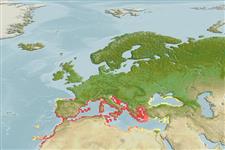Environment: milieu / climate zone / depth range / distribution range
Écologie
marin; eau douce; saumâtre. Subtropical; 45°N - 25°N, 20°W - 45°E
Eastern Atlantic: coasts of Spain and Morocco including Madeira and the Canary Islands. Also in the western Mediterranean, Adriatic Sea and Black Sea.
Taille / Poids / Âge
Maturity: Lm ? range ? - ? cm
Max length : 20.0 cm TL mâle / non sexé; (Ref. 5980); common length : 15.0 cm TL mâle / non sexé; (Ref. 5980)
Description synthétique
Clés d'identification | Morphologie | Morphométrie
Total scales in midlateral series 59-65. Anal fin with 10-12 1/2 rays (Ref. 59043).
Littoral, often near shore. Gregarious, sometimes occurs in marine lagoons (France) and estuaries (Portugal). Feed on pelagic copepods and benthic crustaceans (Ref. 5980).
Life cycle and mating behavior
Maturities | Reproduction | Spawnings | Egg(s) | Fecundities | Larves
Maugé, L.A., 1990. Atherinidae. p. 604-605. In J.C. Quero, J.C. Hureau, C. Karrer, A. Post and L. Saldanha (eds.) Check-list of the fishes of the eastern tropical Atlantic (CLOFETA). JNICT, Lisbon; SEI, Paris; and UNESCO, Paris. Vol. 2. (Ref. 4499)
Statut dans la liste rouge de l'IUCN (Ref. 130435)
Menace pour l'homme
Harmless
Utilisations par l'homme
Pêcheries: hautement commercial
Outils
Articles particuliers
Télécharger en XML
Sources Internet
Estimates based on models
Preferred temperature (Ref.
123201): 16.1 - 21.1, mean 19 °C (based on 523 cells).
Phylogenetic diversity index (Ref.
82804): PD
50 = 0.5312 [Uniqueness, from 0.5 = low to 2.0 = high].
Bayesian length-weight: a=0.00550 (0.00429 - 0.00703), b=3.08 (3.01 - 3.15), in cm total length, based on LWR estimates for this species (Ref.
93245).
Niveau trophique (Ref.
69278): 3.2 ±0.33 se; based on food items.
Résilience (Ref.
120179): Milieu, temps minimum de doublement de population : 1,4 à 4,4 années (Preliminary K or Fecundity.).
Fishing Vulnerability (Ref.
59153): Low vulnerability (10 of 100).
Nutrients (Ref.
124155): Calcium = 130 [79, 276] mg/100g; Iron = 1.31 [0.75, 2.20] mg/100g; Protein = 20.8 [19.3, 22.2] %; Omega3 = 0.379 [0.190, 0.732] g/100g; Selenium = 11.5 [5.3, 25.4] μg/100g; VitaminA = 24.7 [8.7, 69.4] μg/100g; Zinc = 1.45 [1.02, 2.08] mg/100g (wet weight);
